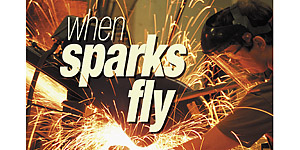
An ironworker crew was modifying a temporary structural steel bridge using an oxygen/acetylene torch set up on a cart with a portable welder and a grinder. The acetylene hose developed a leak and suddenly ignited during the grinding operation. A worker grabbed a nearby fire extinguisher to fight the fire, but the blaze quickly grew out of control. Everyone evacuated, and the fire department was called in to put out the fire. Fortunately there were no injuries, but damage to the equipment and property was severe.
A subsequent investigation revealed that the torch was not equipped with a flashback arrestor check valve. As a result, the fire traveled through the hose into the compressed cylinder. Had the supervisor and crew been trained properly to look for the check valve, this incident might not have occurred.
Welding, cutting and brazing activities constitute dangerous work. They involve such life-threatening hazards as fire, toxic fumes, burns, explosions, electric shock, radiation, noise and heat stress. In order to help avoid situations like the one in the example above, here are six key areas to concentrate on when dealing with welding safety:
1) Hot work permit
If you are using an area not designated specifically for welding operations, you should have a hot work permit system. This system requires an authorized person to inspect the area and make sure all precautions are in place. A prewritten form can be used as a checklist and as an authorization form. Any special conditions, such as inadequate ventilation, should be noted on the form with procedures to be followed.2) Fire prevention
Welding can cause temperatures to exceed 10,000 degrees F. That's why it is so important to prevent fires. The following are some necessary precautions:
- Floors should be made of concrete or another fire-resistant material and be swept clean of any combustible materials, such as wood shavings.
- Combustible materials should be kept at least 35 feet away from the welding operation.
- Cracks in the floor should be filled to prevent sparks and hot metal from entering.
- Metal sheets or fire-resistant curtains should be used as fire barriers.
- Fire extinguishing equipment should be readily available.
- Someone should be assigned as a fire watch.
- Drums, barrels and tanks should be thoroughly vented and purged of flammable materials before any hot work is performed on them.
3) Ventilation
Adequate ventilation is crucial for a safe welding operation because metal fumes and toxic gases can be formed during the process. The type of welding fumes generated depends on the composition of the metals being welded and the welding rods themselves. Fumes may include iron oxide, cadmium, zinc oxide, lead, fluoride, nickel and chromium. Toxic gases formed during welding may include carbon monoxide, nitrogen dioxide and ozone.4) Personal protective equipment
Welders and passersby need to be protected against heat, sparks, ultraviolet rays, hot slag, fumes and toxic gases. Make sure your employees are outfitted with the following personal protective equipment (PPE):
- Helmets or hand shields during arc welding operations.
- Goggles for gas welding or oxygen cutting operations.
- Appropriately shaded lenses.
- Fire-retardant coveralls.
- Leather gauntlet gloves.
- High-top leather shoes.
5) Arc & gas precautions
Certain hazards are inherent in either arc or gas welding. Arc welding carries the risk of electric shock and should be avoided in wet areas. If the welder is sweating, rubber gloves should be worn under the welding gloves. The welding machine frame should be properly grounded; if welding is done on steel or other conductive material, use an insulating mat under the operator. Always remove electrodes from the holder during breaks and when work is done for the day.
With gas welding, flammable compressed gas cylinders are a concern. These should be stored in a dry, well-ventilated area and securely fastened in an upright position. Stored oxygen cylinders should be separated from fuel gas cylinders by at least 20 feet or by a five-foot high, fire-resistant barrier with a 30-minute rating. Lash or chain cylinders that are connected for use. Make sure all cylinders are properly labeled and that hoses are color-coded to avoid using the wrong hose.
6) Training tips
Discuss with your employees any recent incidents involving welding and review preventive actions. Have your workers inspect their PPE during training and replace worn or broken equipment, particularly scratched lenses. Demonstrate correct welding practices, and review first-aid procedures to be used in case of an incident.SIDEBAR: Welding ventilation: Rules to live by
- Provide mechanical ventilation if the space is less than 10,000 cubic feet per welder and the ceiling height is less than 16 feet.
- Ventilation should be provided at a minimum rate of 2,000 cubic feet per minute per welder.
- Use local exhaust hoods and booths to enhance ventilation.
- If necessary, such as during confined space operations, use a supplied-air welding hood or, if fumes are known, a filter type respirator with a filter that protects against the fumes.
- Conduct regular sampling of the air to determine if the ventilation is working properly.



